

Based on the oldest of all movie stories, and relieved by only one "big" setting, "Vaudeville" owes its universal recognition as one of the most brilliant films of the German "Golden Period" to the fact that in it the four production phases of scenario-direction-photography-acting are interlinked to perfection. For this it seems that credit should go to Erich Pommer, who never directed a film himself, but invariably scored successes with films he supervised. Thus, in Hollywood in 1926, he supervised Mauritz Stiller directing Pola Negri in "Hotel Imperial" for Paramount. Returning to Berlin, he supervised a batch of four films which all bore signs of Hollywoodism and cannot but be excluded from the "Golden Period." They were "The Wonderful Lie" (Brigitte Helm, Francis Lederer, Warwick Ward), "The Hungarian Rhapsody" (Willy Fritsch, Dita Parlo, Lil Dagover) by Hans Schwartz), "Temptation" (Gustav Frohlich, Betty Amann) and "Homecoming (or "The Prisoner's Song," from "Karl und Anna" with Gustav Frohlich, Lars Hanson, Dita Parlo) by Joe May. Three of these are available on 9.5mm film. Joe May had for years been a leading German director, and in 1916-17 he directed films from scenarios by Fritz Lang whose own directorial work only started in 1919.
Pommer then proceeded to supervise two more big successes, "The Blue Angel" by Josef von Sternberg with Emil Jannings and Marlene Dietrich, and "Congress Dances" by Erik Charell with Conrad Veidt and Lillian Harvey. Recently in Hollywood, he was responsible for "They Knew What They Wanted." After "Vaudeville," E.A. Dupont also went to Hollywood but failed to achieve any success. Later he made the indifferent "Moulin Rouge" and the interesting "Piccadily" in England for British International Pictures, followed by "Atlantic," which had traces of brilliance but fell far short of the masterpiece that such a theme might well have evoked.
American Critics' Enthusiasm
"Vaudeville" was received with particular
acclaim in America. The result of The Film Daily's annual
canvass to determine the ten best pictures of 1926 ran as follows:
"Variety" (i.e. "Vaudeville") . . . . . 169
votes
"Ben Hur" . . . . . . . . . . . . . . . . .. 114 votes
"The Big Parade" . . . . . . . . . . . . 108 votes
"The Black Pirate" . . . . . . . . . . . 108 votes
"Beau Geste" . . . . . . . . . . . . . . . . 100 votes
All the famous critics gave their ten selections. That of Donald Freeman in the American national magazine Vanity Fair read: "'Variety' - There are unquestionably a few other pictures, but there is no use in going into that."
The available version, though condensed with great skill, nonetheless suffers the inevitable characterisation, continuity and general dramatic losses in being cut to half its original length.
Convict 28 tells his story to the prison governor . . . In Hamburg, "Boss," an ex-trapeze artist, runs a sideshow assisted by his wife. One day a sailor brings along an orphaned girl known as Bertha-Marie. Boss, overruling his wife, accepts her into his troupe, and she lives in their caravan.
Her seductive charm fatally tempts Boss, and he leaves his wife and child and travels to Berlin where he and Bertha-Marie set up as a trapeze act. Artinelli, famous trapeze artist of the Winter Garden Theater, is looking for a partner to replace his injured brother. His manager makes contact with Boss, and the three duly appear at the Winter Garden.
Fame elates Boss. He wins heavily at cards and laughingly refutes the converse suggestion "unlucky in love" while, inevitably, Bertha-Marie and Artinelli come together. Then Boss learns the truth, and, though tempted to fake a trapeze accident, instead challenges and kills Artinelli in his hotel room. Then he gives himself up.
Such is the story of Convict 28. His wife is waiting for him, and he is freed to go to her.
The very simplicity of this material allows footage to be devoted to intimate character studies that are impossible in more involved stories. Given the skeleton quoted above, the scenario-writer has very carefully chosen incidents full of cinematic action-value which will recount the story while allowing full opportunity for characterisation. For example, Artinelli and Klereck are greeted on their arrival at the caravan by a pail full of dirty water flung out by Boss. Contrast this bit of action with its glimpses of the reactions of the three concerned with countless similar scenes where the meeting has taken place without any attempt at adding a pictorial comment.
Consider also the incidents of the dripping tap and the stocking darning, both being based on pure action and fitting exactly into the pattern of the narrative and the characters involved. The other point of note about the simple narrative is that the whole story is told as a flashback. This was in no way original - it was used in 1919 in "The Cabinet of Dr. Caligari" - but never before nor since has it been so admirably exploited. A gloomy and sinister opening is made possible in keeping with the story, and above all, an artistically sound "happy ending" is logically yielded, complete with one of the most superb and memorable last shots ever put on the screen.
Triumph of the Cameraman
To the director and supervisor must go a large share
of credit for rendering with such technical and dramatic skill
this obviously inspired scenario, and for controlling with perfect
balance a fine cast led by the already famous Jannings. But above
all, Karl Freund stands out. For the second time in film history,
the camera left its usual objective detachment and became an integral
part of the drama. It achieved fluidity and mobility, and its
compositions were matters of studied artistry, adding to the scene
a unique intimacy not yet understood by the vast majority of cameramen
and directors.
This use of the camera was the inspiration of director F.W. Murnau for his 1925 production "The Last Laugh" with Jannings, famous in particular because through its 6,900 feet, it had only one subtitle. This also was photographed by Karl Freund. The full cinematic significance of these photographic effects will be explained later. It is worthy of record that throughout 1926, in which year "Vaudeville" took America by storm, not one solitary mention of the film was made in the leading photographer's magazine, The American Cinematographer, which was the official journal of the American Society of Cinematographers (A.S.C.), whose motto was Loyalty-Progress-Art. There was, however, on indirect reference: the editorial comment in the August number one an article in Film Daily praising Freund's camera angles ran, "Many of the angles mentioned in the article in question, according to Gilbert Warrenton, A.S.C., would appear palpably crude if they were incorporated in American productions, for the simple reason that they were discarded as obsolete in the Middle Ages of cinematography."
Warrenton*** never photographed anything of distinction himself and was merely unimaginatively competent. For example, his work can be seen in "Oh, Doctor" (late 1924 by Harry Pollard with Reginald Denny). This, a pleasant comedy, is available on 16mm. It is thus possible to inspect the photography of "Vaudeville" and "Oh, Doctor" and compare one with the other. And it is very, very easy to see which is art and which is mere science. The tragedy is that Karl Freund himself drifted later into the ranks of the competent but uninspired. Thus we could not distinguish his work from that of countless others in "A Letter for Evie" (1945 by Jules Dassin). In cinema, direction and photography are mutually inspiring.
The September 1926 Picturegoer said, "'Vaudeville' is Germany's best effort to date; streets ahead of anything yet produced; it is as amazing as it is magnificent - the marvelous production of a drama that holds one spellbound."
Contemporary big films included "The Dark Angel"
(Ronald Colman-Vilma Banky), "The Sea Beast" (John Barrymore,
Dolores Costello), "Lady Windermere's Fan" (by 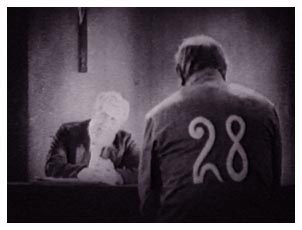 Ernst Lubitsch), and "Stella
Dallas" (by Henry King with Belle Bennett and Ronald Colman).
Ernst Lubitsch), and "Stella
Dallas" (by Henry King with Belle Bennett and Ronald Colman).
Slow iris-in.
L.S. The Prison governor sits at a table. An accent light picks
him out, and soft floods partly show a crucifix on the bare wall
behind. A warden enters . . .
TITLE: "Bring No. 28 here to me."
L.S. - The warden goes out . . .
F-L.S. Convicts file round in a deep enclosure . . .
L.S. No. 28 is led away down a long, dull passage. . .
L.S. . . . into the presence of the Governor.
The composition, matching relevant dramatic content, and timing of these shots are remarkable. Where necessary to preserve the slow tempo, they are held before or after the normal commencement of the action. The governor induces No. 28 to tell his story for the first time since his arrest ten years ago, showing him a letter from his wife entreating him to secure a pardon. Only the back of No. 28 is shown. Due to careful posing and uniquely careful lighting and camera-angles, a great sense of sorrow and weariness is conveyed. "Vaudeville" has been referred to as "the film Jannings acted with his back to the camera" - and, indeed, the grouping has, throughout the film, in many cases been specially arranged to achieve this. Its effectiveness is as indisputable as its string of imitators.
The action then shifts to a fair at Hamburg, established in a few glittering long shots. Boss is shown in harsh, full close-up jangling a bell and yelling praises of his squalid sideshow, the girls being separately introduced in hard medium close-ups that are painfully uncompromising. The troupe then strips as far as permissible and proceeds into the "theatre," avidly watched by tough dockers. Boss shouts them in and takes their money. This admirable shot, Boss's back near the camera, is a study in composed movement. Within, we fade out on the uninspiring show.
At supper in their caravan, Boss and his wife and baby are shrewdly introduced by the famous dripping tap sequence, which is cinematically simple - pure contrasting of detail shots - but lifted into the ranks of minor masterpiece by the studied details of action. Thus, Boss carefully removes the last vestige of a drip from the tap with his finger. His wife pauses just in the act of cutting a round of bread. And, superbly, Boss pauses on the verge of a resumed spoonful of soup when he realizes that his son is guilty and the tap innocent. The cutting is expertly fluid, cutting on action being arranged to change from close-up to mid-shot and vice-versa when Boss leaves the table. In addition, the confined space of the caravan is accurately portrayed, and the soft lighting adopted is admirable.
"She's Staying"
As Boss expertly fixes up his baby with clean nappies,
a sailor enters with a girl . . . . "We had a woman and her
daughter aboard. The woman's dead." In mid-shot the girl
comes into view as she climbs the caravan steps. She is of distinct
beauty, enhanced by nervousness. In close-up, Boss's wife reacts
with inevitable suspicion. Boss unashamedly likes this orphan,
named after the ship Bertha-Marie. He takes up the hint
to include her in his troupe. Walking from the camera in long
shot, his wife openly speaks her dislike. Boss emphatically states,
"SHE'S STAYING." The wife sullenly gets out blankets.
We somehow realize she has only just lost her prettiness of youth.
The intimacy of the whole sequence is amazing. The audience is
brought right among the characters. Drinking with Boss, the sailor
says, "She dances well and is good on the trapeze."
He goes out. The girl cowers on her bunk. Boss goes diffidently
to his wife and suggests reviving their trapeze turn - and is
rebuffed. The cool cynicism of this lumbering suggestion by Boss
is accentuated by the swift and scornful reply of his wife.
Bertha-Marie is an undoubted attraction at the sideshow. Boss brutally compares her body as she dances with that of his wife at the piano, and throws away his cigarette in disgust. The comparison is done by intercutting suitable shots with medium close-ups of Boss switching his eyes from one to the other. In the caravan, he bids his baby goodnight, carefully fanning away a little cloud of cigarette smoke - another nice touch. In close-ups acted with studied perfection, as he undresses, he contrives not to look (except perhaps accidentally) at Bertha-Marie's preparations for bed.
Then the baby cries, and she goes to the cot. Boss strikes her away with a force exaggerated in order to hide his real, dangerous feelings. This is emphasised in the montage of the sequence, the blow being partially repeated. In mid-shot, the action is held right up to the blow. In the succeeding close-up, four frames pass before Boss' hand appears in the picture. The girl limpidly beseeches forgiveness, but he resists her and pushes her aside and lumbers through the curtains to his wife. (End of reel 1)
A Significant Sequence
One evening, over-attracted by the dancer, a docker
ventures onto the stage. Boss is instantly roused. A swift tracking
shot ending in full close-up of the docker expresses the impinging
of Boss' threat. He raises his hat in mock courtesy and moves
away. Boss' wife watches, nervously, as she realizes the emotional
conflict . . . Boss declares the show over. Catcalls greet him,
but the audience files away. And his wife sobs on a bench in the
empty, drab tent whilst Boss goes to the girl.
At the Winter Garden, Berlin, a show is indicated by straight shots of several turns, one being intercut with shots of the audience watching through binoculars, the performers being seen as multiple images in the glasses, by the convex mirror effect. Artinelli is introduced as an unaccustomed member of the audience. He leaves with Klereck, his manager, who later sees Boss and Bertha-Marie doing a trapeze turn in an adjacent show. Their turn over, they proceed to their caravan where, in a sequence of frothy brilliance, Boss fans the girl with a towel and mops her face.
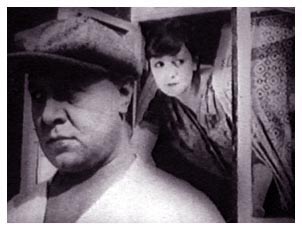 An effective close-up of Boss from
the girl's eyes shows the flapping towel. There occurs here a
rare technical error. The tempo of the towel-flapping varies between
shots, and the cuts are incorrectly situated in regard to the
flapping cycle. A counter close-up of the girl from Boss' eyes
shows the towel removed and Boss' hand fervently touching her
delicate skin. The embrace that follows is photographed in full
close-up with beautifully rendered light and shade. Meanwhile,
Klereck reports his find to Artinelli who is impressed . . .
An effective close-up of Boss from
the girl's eyes shows the flapping towel. There occurs here a
rare technical error. The tempo of the towel-flapping varies between
shots, and the cuts are incorrectly situated in regard to the
flapping cycle. A counter close-up of the girl from Boss' eyes
shows the towel removed and Boss' hand fervently touching her
delicate skin. The embrace that follows is photographed in full
close-up with beautifully rendered light and shade. Meanwhile,
Klereck reports his find to Artinelli who is impressed . . .
They call on Boss as he flings out his basin of water. They talk business. Artinelli sees Bertha-Marie at the window, and the partnership is agreed. They go off, and Boss re-enters the caravan to be greeted by a hole in a stocking which he proceeds to remove and darn. The above is perfectly conveyed without a single subtitle. Then Boss nonchalantly mentions the proposal and smiles a superb smile at the girl's thrilled enthusiasm . . . (End of reel 2)
Sensational Brilliance
The action now logically proceeds to the point where
"The Three Artinellis" take the stage together at the
Winter Garden. Great shafts of light dramatically pick them out
against a black background. The orchestra strikes up. They climb
the rope ladders and gain their platforms near the roof. Their
turn is presented with sensational brilliance. The camera has
complete mobility, some shots being taken from a platform representing
a trapeze which must have given Karl Freund the germ of the "flying
camera" idea. The audience reactions are also admirable.
It appears that doubles were used (The 3 Codonas) for the risky
trapeze scenes, but so so carefully intercut that they are completely
lost in the brilliance of the whole. The anti-climax of the climb
down is obviated by intercutting audience reactions in which glasses
are used to lend an effective fringe to their corresponding "seen"
close-ups. The show fades out as the curtain descends. This and
the later sequence were actually shot in the Winter Garden Theatre,
only some of the close-ups being done in the studio.
In her dressing room, Bertha-Marie and Boss revel in their
success. Artinelli waits, shown plainly as a menace, sinister
and diffused against a dead background. He gives the girl a ring.
Boss is puzzled, then pleased. Then the company celebrates. In
opening long shot, filmed through an electric fan, the party is
seen to be already very gay. Boss snaps 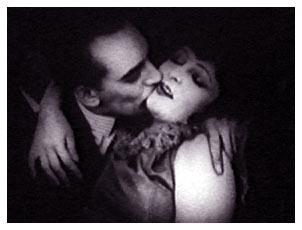 a
rhythmic finger with the rest. A hat, flung away, lands on the
out-of-place Klereck. Bertha-Marie takes the table with a rather
unsteady dance. Boss picks her up and throws her . . . and it
is Artinelli who makes the catch. Then,
a
rhythmic finger with the rest. A hat, flung away, lands on the
out-of-place Klereck. Bertha-Marie takes the table with a rather
unsteady dance. Boss picks her up and throws her . . . and it
is Artinelli who makes the catch. Then,
C.S. A hand switches off the light.
TITLE "Three o'clock. Closing time!"
C.S. Artinelli has stolen a kiss.
M.S. The manager restores the light.
M.S. The party makes to disperse
MIX TO
C.S. Hats are taken from the rack. Fade out.
TITLE "Next morning at the Artists' Café."
. . . Boss is shown playing cards. The logical sequence
of ideas is the key to the constructional perfection of "Vaudeville's"
scenario. One has sensed already that he will be lucky at cards.
Meanwhile, Artinelli contrives to get the girl into his hotel
room. Four shots in this sequence are quoted as a particularly
fine illustration of the subjective use of the camera. After Artinelli
has placed his (clean) shoes in the passage,
C.S. He very carefully closes the door.
C.S. His head, listening . . . TRACK UP TO -
FC.S. his ear . . . VERY SLOW MIX TO -
L.S. Bertha-Marie's feet approaching along passage . . .
CM.S. (TRACKING SHOT) (as seen from her eyes) the door. He comes
out and picks up his shoes, looks up and smiles as he sees her.
Boss is lucky at cards.
As Artinelli struggles for a kiss, the camera sways in a manner reflecting the man's abandon. A routine symbol with the Venetian blind covers the seduction.
Imaginative Lighting
Later the unsuspecting Boss asks Artinelli to take
Bertha-Marie to a fete. The reactions of the two are fraught with
cynical humour. At the fete they are seen by an actor of their
company. At 4 a.m. Boss sits moodily on his bed, wondering. Though
Jannings had a masterly command of expression, Freund assisted
him as can readily be seen by comparing the lighting of this close-up
(worried, uneven light accentuating frown and shadow on right
eye) with that used for the close-up at the card game (uniform,
symmetrical, no hard shadows). Pausing to repair her make-up in
a mirror close-up skillfully contrived, Bertha-Marie enters their
room, sees Boss's eyes flick open, but knows she can manage him.
She does so at his challenge. He stands, back to the camera, almost
completely reassured, as the scene fades out. (End of reel 3)
For the sustained perfection of its film technique, the last reel of "Vaudeville" stands ahead of anything else available on sub-standard film (including reel 4 of "Potemkin" with the Odessa Steps sequence) and should definitely be seen at least once every year by everybody in any way connected with films, amateur or professional. Though an "S" reel [notched title], it contains only four subtitles and can be shown on any 9.5mm projector - the loss, if no still device is fitted, being negligible.
Emil Jannings dominates this last reel. Born in 1886, his
films include "Madame Dubarry" (1918), "Waxworks"
(19214, with Werner Krauss and Conrad Veidt), "Quo Vadis?"
(1924), then in 1924, "The Last Laugh" and "Tartuffe"
(1926) by F.W. Murnau, and "Vaudeville," followed by
"Faust" (1926). He then went to America and made six
films, including "The Patriot" and "The Last Command,"
after which the talkies caused his return from retirement by request
each time with indifferent results. In "Vaudeville"
he had excellent support from Lya de Putti ("Manon Lescaut"
and "The Informer"), Warwick Ward ("The Wonderful
Lie" and "The Informer"), and Maly Delschaft ("The
Last Laugh"). Lya de Putti died in 1931 at the age of 27.
"Vaudeville" was Warwick Ward's first film in Germany.
The settings of "Vaudeville" production, which overlapped
the starting of work on "Metropolis," were by the same
architect-designer, Oscar Werndorff. So real are they, one hardly
realizes they were studio designs. The Bioscope of 12/1/1926
remarked, "With a degree of emotional intensity seldom reached
on the screen is presented this violently passionate, yet always
human drama in settings which express the glamour and excitement
of circus and vaudeville life with a realism never before approached."
The last reel opens with a shot of a drawing on a café
table that eloquently explains the truth. Boss comes to the table,
and the drawing is concealed by an arm. He goes - but returns
for his forgotten cigarette case. Made suspicious by the elaborate
nonchalance of the waiter, he looks down and sees the drawing.
. .
CM.S. (his back to camera) he stands, looking at the drawing.
S.S. (from over his shoulder) - his hands on the table . . .
CM.S. Slowly he raises his eyes, turns his head . . .
M.S. (PAN) (from his eyes) the camera sweeps, with increasing
speed round the café.
M.S. (low angle) he holds the table above his head and hurls it
. . .
C.S. . . . down on the floor . . . it smashes to pieces.
M.S. (outside) Klereck and the actor realise what has happened.
C.S. Boss stands, his face quivering with jealousy and rage.
M.S. (outside) Klereck nervously moves away.
M.S. Boss plunges through the revolving doors, up to the actor
and . . .
C.M.S. . . demands the truth . . . he replies . . .
TITLE "Boss, it is true I tell you. I saw them yesterday
evening."
C.M.S. He edges away. Boss stands alone.
TITLE "That evening the time came for the Artinelli to appear
at the Winter Garden."
M.S. (Fade-in) Artinelli dons his black cloak.
C.S. Boss, full of conflicting thoughts. Waving lights are super-imposed.
MIX TO C.S. Artinelli on trapeze.
C.S. (feet only) he jumps off.
L.S. . . . leaves his trapeze, completes double somersault, but
Boss' hands are short; he falls . . .
L.S. . . . he falls . . .
L.S. (tracking shot, vertically downwards towards the audience
below) . . . they rise to their feet.
L.S. the trapeze continues swinging . . .
L.S. (from high in the roof) commotion in the audience.
M.S. horrified members of the audience.
M.S. (looking vertically downwards) Artinelli lies still. MIX
M.S. Artinelli, awaiting their call.
C.S. Stage manager switches warning light.
C.S. Warning light on.
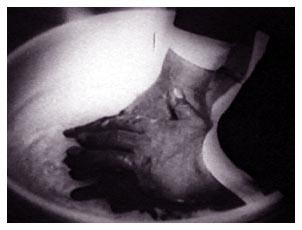 C.S. Orchestra conductor's baton
taps.
C.S. Orchestra conductor's baton
taps.
. . . and then the performance starts, spectacular in itself, but here given tremendous extra drama by the conflict depicted in Boss' mind and the suspense of wondering whether the "accident" will happen. Klereck, overcome with anxiety, leaves during the act. Swinging on the trapeze, Boss is conscious of the sea of eyes and the applause, which he mechanically acknowledges. The eyes are a memorable multiple-exposure, superimposed on light flashes. The close-ups of Boss on the swinging trapeze are superlative. Long and mid-shots of perfect composition and sure direction vividly portray the enthusiastic applause of the vast audience. Then, without incident, the show is over.
Photographic Artistry
Back to the camera, and deadly still, Boss waits in
darkness in Artinelli's room. As the door opens, light plays on
his shoulders - another detail of photographic artistry. Artinelli
is shakily drunk and
CM.S. he sways as he looks at . . .
C.S. (camera wobbles drunkenly) . . . Boss . . .
C.S. Artinelli looks with watery eyes.
FC.S. Boss looks, with menacing gaze.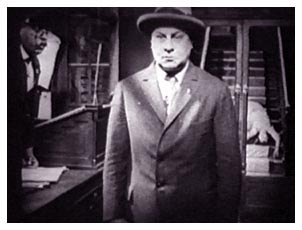
Again, the camera has been used subjectively with perfection. The angles employed throughout the fight that follows are chosen with great skill and incorporate a certain symbolism. The last shot of the fight is laden with chill horror. Struggling, Boss and Artinelli drop out of camera range, but the shot is held, looking across the room towards the bed. Then, at last a hand appears with a knife, but drops, defeated. And then Boss stands up. He shudders. Passionate rage has left him.
He goes back to his room. Bertha-Marie smiles up from bed
as the light goes on. Then she looks puzzled at his appearance.
He counters with a look of mock amazement, goes to the wash stand
and pours out water. As he immerses his hands, the water is stained
with blood. The girl cries out. He walks relentlessly away. Through
the door she sees Artinelli's body (shown by C.S. of one hand
on the floor) and cries out again after him. He proceeds mechanically
down the stairs, deaf to her desperate "EMIL" (curious
use of the real name of actor, as Boss' Christian name is unstated)
and heedless of her stumbling rush down the stairs. He passes
the wondering porter, hails a taxi, states, "Police station,"
and . . .
C.S. sits tensely down.
MIX TO C.S. Convict 28, his story told . . .
L.S. the prison governor walks round to him, takes his hand, silently
intimates that he has repaid . . .
C.S. slowly the convict raises his head. And now there is a light
in his eyes, and the suspicion of a smile upon his lips. MIX TO
L.S. (from within) the great doors of the prison swing open, and
beyond there is the joyful beauty of sparkling sunshine, with
lofty poplars swaying in the wind, singing of freedom and peace.
* The only version that is commercially available today is the American release which totally excised the story of Boss and his wife, the arrival of Bertha-Marie and Boss leaving his wife to run away with Bertha-Marie. Instead, the version available for viewing today begins with Boss and Bertha-Marie as a husband and wife trapeze act. The Americans cut German pictures by 2-3 reels as a matter of course. It is interesting that 83 years later, the Germans still haven't restored what is probably their greatest silent film. A restored print with the complete story intact is supposed to be in the works, but Murnau-Stiftung have been saying that for years.
** The 3 Codonas had a film about them made in Germany in 1940 under that title.
***Ironically, a few months later, Warrenton was referred to in the trade press as 'the American Karl Freund.' Anthony Bulleid must have forgotten his outstanding work with the mobile camera on "The Cat and the Canary" (1927, Paul Leni), "Lonesome" (1928, Paul Fejos), and "The Man Who Laughs" (1928, Paul Leni).